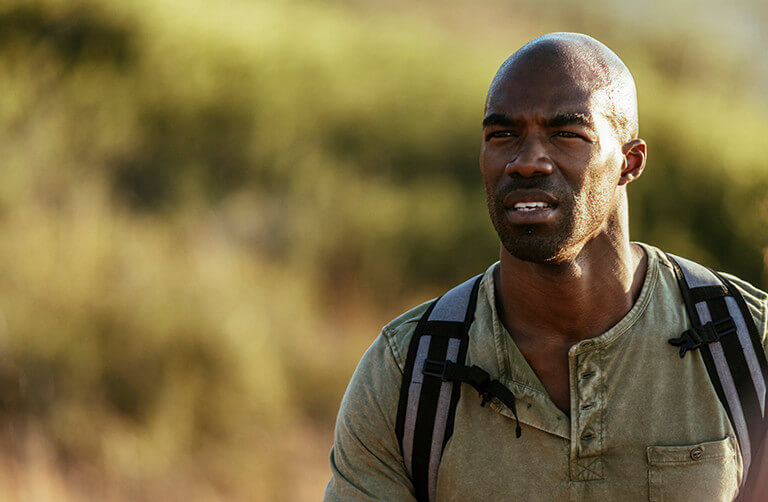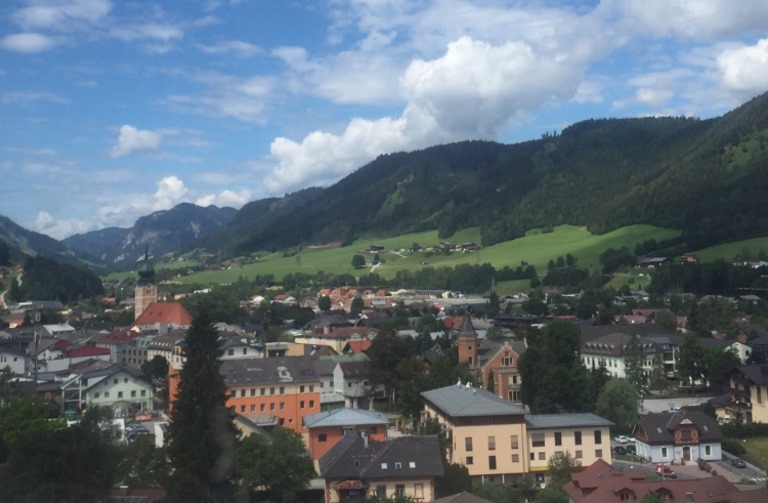Less crowded than its neighbors, Slovenia abounds with outdoor activities and jaw-dropping scenery, not to mention great food and wine. Join nomad Bill as he hikes and kayaks at Lake Bohinj, goes rafting on the Sava Dolinka River, and samples local wine in the Vipava Valley.
 Photo © Bill Fink
Photo © Bill Fink
Atop Slovenia’s Mount Vogel, I watch a multi-hued array of paragliders swirling in the thermal winds of the Julian Alps. 1000ft (330m) below them, kayaks ply the dazzling blue waters of Lake Bohinj, paddling to small beaches bordered by vibrant pine-tree forests. From the grassy alpine meadows below me, I hear the faint rattle of cowbells. My hiking group descends from our viewpoint through a stunning panorama we share with wandering cows and mountain goats.
It's just another glorious summer day in Slovenia, where I’ve come for outdoor adventures, with a bit of culture, wine, and honey added to the mix. Long underrated as merely a transit point for tourists en route to its more famous neighbors of Italy, Austria, and Croatia, Slovenia has come into its own, offering a full array of activities all packed into a country half the size of Switzerland but with just a fraction of the visitors.
- The “Green Capital” city of Ljubljana
- Mountain adventures around Lake Bled and Lake Bohinj
- The Walk of Peace hiking trail
- Land of food, wine, and honey
- Trip notes
The “Green Capital” city of Ljubljana
I begin my journey in Slovenia’s capital city of Ljubljana, where I wander old town streets free from vehicle traffic, and cobblestone walkways lined with an interesting assortment of blunt Yugoslavian socialist government buildings, quaint Austrian-style churches, rough Bosnian diners, posh Western European cafes, all topped off with a medieval castle looming on a hilltop. Entering the downtown-adjacent Tivoli Park, with its ornamental gardens and access to a huge network of hill trails, it’s easy to see why Ljubljana won the annual “Green Capital of Europe” award in 2016 – 75% of the city territory is parklands.
A guided city walking tour provides me with a helpful historical and cultural orientation, showing how the small puzzle piece of Slovenia fits into the patchwork of central and southeast European cultures. My guide quips that the country’s “combination of Austrian strictness and Balkan looseness” means that “you can drink wine all day long, but the buses still run on time.” Given the variety of cuisine in this culinary crossroads, I also take a guided food tour of the city, enjoying a smorgasbord of treats ranging from delicate Austrian-style pastries to finger-licking greasy Bosnian meat pies, along with tastings of local wines, cheeses, and honeys (for which Slovenia has historic fame).
At night, I stroll along Ljubljana’s lively riverside district, with dozens of bars, cafes, and restaurants and entertaining people-watching, with city squares providing an ad-hoc stage for street performers and live music.

Mountain adventures around Lake Bled and Lake Bohinj
I take a public bus from Ljubljana to Lake Bohinj, allowing me to sit back for a couple hours to appreciate the incredible variety of landscapes in this small country. Flat farming fields make way for towering granite peaks as the apartment block-choked city outskirts dissolve into quaint mountain villages with small white church spires, and nearby foothills criss-crossed with vineyards.
Arriving near the shores of Lake Bohinj, I stay at a typical Slovenian guest house, its basic rooms opening to stunning mountain views. Included breakfast (bread with honey, of course) comes with a bonus of local color, as a neighborhood senior-citizen posse descends on the area for their daily coffee, smokes, and chat.
A short walk reveals the majesty of Lake Bohinj, an Alpine paradise with glassy waters disturbed in the early morning only with the ripples of a few paddling ducks. Lakeside watercraft rental options abound, a full navy of kayaks, paddleboards, rowboats, sailboats, and paddleboats launching to displace the annoyed ducks. I enjoy a paddle for a picnic on a nearby beach, walking some trails along the shore. The next day, I join a white-water rafting tour to the nearby Sava Dolinka River, a fun, splashing adventure. A side trip to the tourist-heavy Lake Bled, nearby, offers the highlight of a gondola trip to the Bled Island Church of Mary the Queen.
From Bohinj, my adventures continue on land, renting a bike for a pedal through surrounding villages full of picture-postcard wooden homes with bouquets of flowers lining nearly every window and balcony. I bike along a well-paved path traversing fields of wildflowers, shaded riverside bends, and rolling hills, enough to make me want to yodel (assuming I ever catch my breath).
The fresh mountain air inspires me to continue my adventures, this time by foot, hiking Mount Vogel overlooking the lake. Thankfully, the ski resort’s gondola takes me three-quarters of the way to the peak at 6300ft (1920m) elevation, but the rocky climb to the summit still proves to be a challenging hike, with a reward of jaw-dropping views.
Despite my peripatetic sporting trips, I realize I’ve only scratched the surface of Slovenia’s many adventure options. Local companies advertise zip line tours, underground spelunking expeditions, paragliding lessons, horseback riding, canyoneering, and every manner of hiking tour, including the recently inaugurated and expanded Walk of Peace.

The Walk of Peace hiking trail
In 2015 – the 100th anniversary of the bloody WWI battles along the Isonzo Front between Italy and Austria-Hungary – a set of 15 hiking trails were linked to create the approximately 143-mile long (230km) Walk of Peace tracing a path from the Slovenian Alps to the Italian Adriatic Sea by Trieste, Italy.
The trail memorializes the lesser known but still bitterly savage battles along the Soca Valley in what is now northwestern Slovenia. You can walk on multi-day guided tours and self-guided daily excursions past hundreds of historical markers, ranging from cemeteries to churches, memorials, preserved battle trenches and small museums – including the important Walk of Peace Visitor Center in Kobarid, near the northern end of the trail. Since its inauguration, the trail has expanded to cover many new spur trails exploring this spectacularly beautiful and tragically historic mountain region.

Land of food, wine, and honey
After all my adventure activities, I figure I’ve earned some of the epicurean treats of Slovenia. Meals around my Bohinj base range from savory wild boar roasts to light toasted veggie combos, towering strudels and juicy burgers, all washed down with inexpensive and tasty local wines and some noteworthy Slovenian microbrews.
I rent a car to journey to further explore Slovenia’s wine and honey. The country has been famous for its honey since the 18th century when Hapsburg Queen Maria Theresa developed a taste for its product. Nowadays, apiaries line the hills and backroads, many offering visits with tastings, including Beekeeping Ambrozic, about a 40-minute drive from Bohinj. There I gear up in a full beekeeping suit to open the beehives with their traditional hand-painted panels and try some fresh-from-the-hive honey. Intrigued, with bee culture, I drive 15 minutes south to the Museum of Apiculture in Rodovljica to learn about the country’s love affair with honey-making.
I continue my drive an hour south to the Vipava Valley to find some local wines to pair with my bread and honey. The town of Vipava has several tasting rooms, giving me tips for visiting some of the vineyards in the hills – some humble family farms, others slick Napa-style operations with visitor tours. My wine country excursion culminates with a late afternoon lunch and homemade fruit brandy tasting at the impossible-to-pronounce Sinji Vrh restaurant atop a scenic peak, where I watch more paragliders swirl in the sky, bookending my Slovenian mountaintop travels from rough hiking to sweet desserts.
Trip notes
Public buses are readily available for cross-country trips, and as the guide mentioned, run on time. Renting a car is important if you’re branching out to explore more rural areas. My ride from Ljubljana to Bohinj (about 50mi/85km) took about 2.5 hours by public bus with many stops. You can cut the time in half by driving yourself – the roads are good, though care should be taken on winding mountain routes, particularly in winter. While some notable luxury lodging exists around the country, most guest houses are in the two- to three- star range, focusing on location and practicality, rather than luxury and services.
The country has a wealth of tour operators, both for day trips and longer tours, with daily rentals of bikes, kayaks, and other gear easy to come by in tourist-friendly towns. Summer high season can be busy in tourist hubs like Lake Bled and Bohinj – consider visiting during spring and fall shoulder seasons for lighter crowds. Winter sports are hugely popular as well, with many ski resorts including Mt. Vogel at Lake Bohinj.
For more info, explore the country’s excellent tourism website.
Related articles
Simple and flexible travel insurance
You can buy at home or while traveling, and claim online from anywhere in the world. With 150+ adventure activities covered and 24/7 emergency assistance.
Get a quote


1 Comment
I was in Slovenia in June, for only two and a half days, which limited my exploring to the capital and Lake Bled.
Next time I return, I'll be sure to visit Lake Bohinj, plus a sight that you didn't mention, the Soča River, a stunningly blue alpine river.